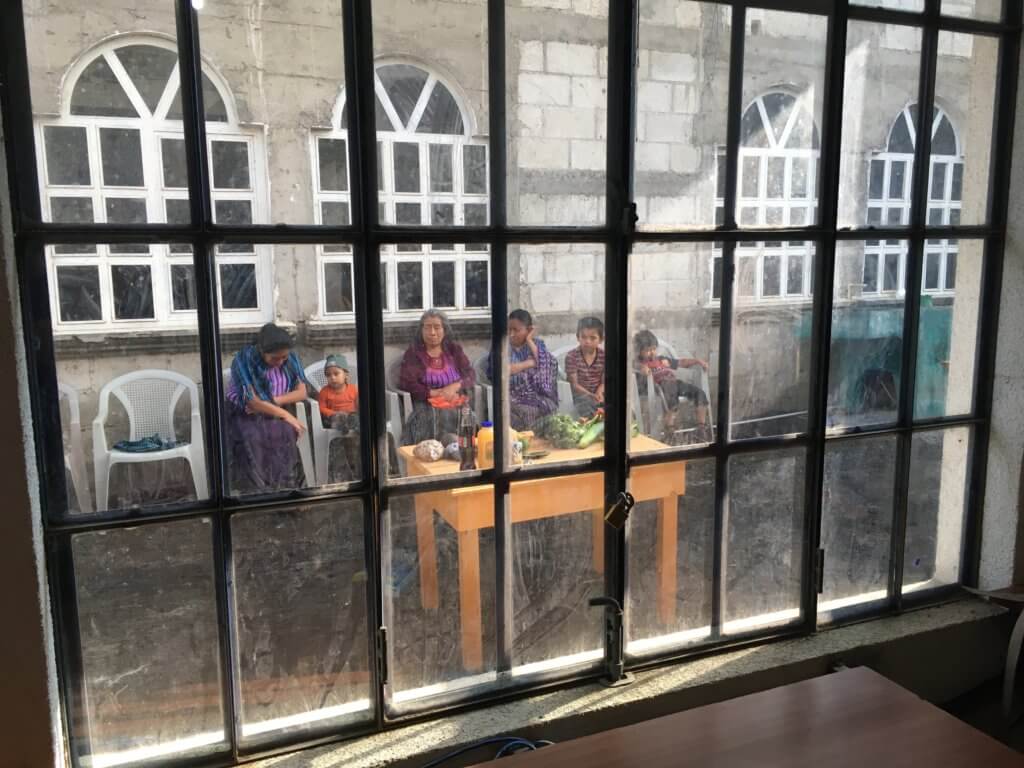
I just returned from an amazing 10-day experience in Guatemala where I was part of a mission group working in the local communities surrounding Lake Atitlan. I won’t be able to do the whole trip justice in a single blog post, but there were some key aspects that relate to this series that I wanted to share.
My assignment for most of the week was in the health and wellness clinic as the toothbrush and toothpaste distributor. I also stepped into a much-needed role of patient flow coordinator. Who said I’d never use that Lean/Six Sigma again?! This photo was taken looking out from the first clinic where we worked in the town of Tzan’chaj.
When we got to a new space each day, I’d help get everyone organized, determine where we’d do registration, and where the patients and families would wait before they would be sent on to the doctors.
It had been 20 years since I’d last been to Guatemala, but I was amazed at the amount of Spanish that came back to me. However, my 12-year old, who was also on the trip and has been in Spanish Immersion for the past 8 years, was not so amazed as she constantly felt the need to correct my grammar. I finally told her “hey, it’s been 20 years, we’re lucky I found the right verb! Let’s not worry about how I conjugated it!”
While my daughter was embarrassed by my attempts with my rusty Spanish, I kept trying. However, in many cases it was futile as many of the villages/towns we were working in speak the Mayan language of Tz’utujil (“suit-to-wheel”) which is nothing like Spanish. It’s a very different (and throaty) language so I felt like I was starting from scratch.
We were blessed to partner with local organizations and in many cases had interpreters who spoke both Spanish and Tz’utujil. Each of the doctors needed an interpreter and we generally had one person at registration who spoke both languages. But, when it came to my toothbrush/toothpaste distribution, entertaining those waiting to see the doctor, and directing them when it was their turn, I was on my own. My attempts to learn Tz’utujil on the fly proved far more frustrating for me (old dog/new tricks) and confusing/humorous to them than it was worth! In all seriousness, the language barrier really gave me a new appreciation for what many of our patients go through when English isn’t their first language or, for that matter, when we speak in medical jargon instead of plain language.
While interacting with patients, I tried desperately to incorporate what patient experience principles I could:
- I’d introduce myself and ask the patient’s name, which I could rarely understand much less pronounce correctly. As a visual learner, I found that if I could see the person’s name written, I was generally better able to remember it. So, I’d use their registration form to help me remember and use their name.
- For lack of anything else to make a connection with the patient, I’d attempt to match the handle of their toothbrush to what they were wearing! Then I’d try with my broken Spanish to tell them as much. It usually got a half-hearted smile but at least it was something.
- When I finally took the patient back to the doctor, I’d introduce both the doctor and interpreter by name to the patient and family, hoping that most of them knew “El Doctor se llama Pat” and “Y mi amiga se llama Carolina” meant that this was “Dr. Pat and my friend Carolina!”
At the end of the day, the one thing I could do that I knew would make a difference almost without fail, was just to simply smile. You see, no matter what the language, that was something that everyone understood. And that’s my takeaway for this series: when all else fails, even if your other attempts are frustrating or confusing or embarrassing, just smile.
And here’s the thing about smiling: I used to fight back when people characterized the classes that we conduct with organizations as “smile school” or “charm school.” I always tell staff in our workshops that I’m not asking them to do anything that is not genuine or authentic. But then, I was working with a frontline team in Missouri and we discovered something to the contrary. With smiling, this is one aspect where “faking it until you make it” can benefit you. For those of you not familiar, scholars William James and Carl Lange created the James-Lange theory which was the first to argue that physical changes trigger an emotional reaction and not vice versa. So, even when you don’t feel the emotion that goes along with smiling (maybe you’re having a bad day or otherwise feeling down) the physiological act of choosing to make your facial muscles smile can actually help change in your internal mood. I mean, come on, why wouldn’t you want to at least try it?
Below I’ve shared some links below of articles about smiling that resonated best with one of the frontline teams we were working with recently. While these aren’t maybe the scholarly journal articles that sometimes the physician community likes to look at, these are written at a level that seemed to really connect with other frontline staff (housekeepers, transporters, nursing assistants, front desk staff, etc.) Feel free to use them with your teams as you talk about the benefits of smiling. Stay tuned with us next time when we’ll dive into some other key aspects for frontline staff that make a difference to patients!
9 Surprising Reaons Why You Should Smile More
11 Surprising Reaons YouShould Smile Every Day
Why Faking a Smile Is a Good Thing
There’s Magic In Your Smile – How Smiling Affects Your Brain
Benefits of Smiling
